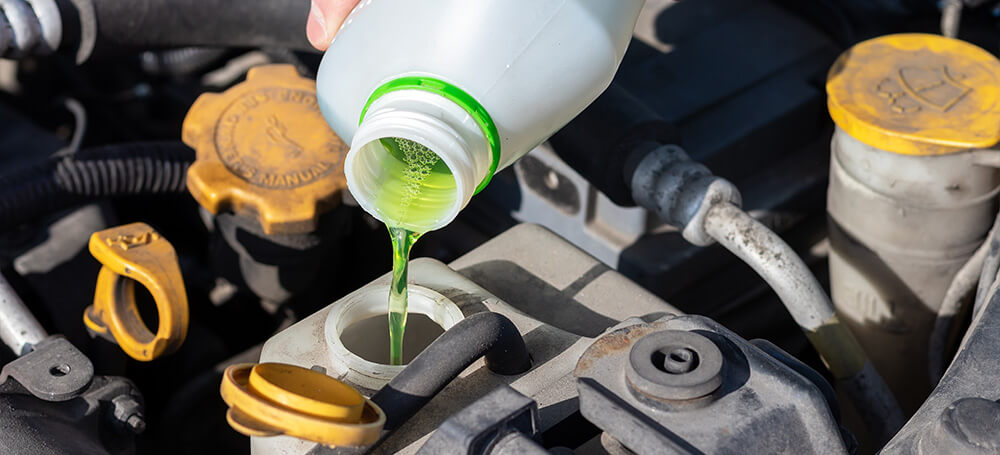Coolant is a colored liquid with many important functions that keep your car running its best.
It’s essential for maintaining a consistent operating temperature in the engine. Coolant keeps water in your engine and radiator from boiling over in extreme heat or freezing in cold weather.
Beyond regulating temperature, coolant also lubricates internal engine components and protects against corrosion. Over time, however, coolant breaks down and becomes less effective. It begins to corrode itself, which is part of how it protects engine metals—but once it reaches a certain point, it can no longer do its job.
Driving with no coolant in your car, low coolant, or dirty coolant can lead to large issues and costly repairs.
Most manufacturers recommend a coolant flush every 30,000 miles or every 2 to 5 years, depending on your vehicle. You can find the exact recommendation in your owner’s manual.
Your cooling system includes several components: the coolant reservoir, radiator, hoses, fan, thermostat, and water pump. When your engine is running, coolant circulates through the engine, absorbing heat, and then flows back to the radiator, where it’s cooled before starting the cycle again.
The coolant reservoir is typically a clear plastic tank with brightly colored fluid inside. You’ll see “MIN” and “MAX” markers on the outside—this helps you check the coolant level without opening anything.
If your engine overheats or the temperature gauge rises, it could mean your coolant level is too low or the coolant can no longer regulate heat effectively. Either way, it’s a sign your cooling system needs attention.

Low coolant levels, visible leaks, or steam coming from under the hood are all signs your cooling system needs immediate attention.
With a full coolant flush, all fluid is drained, and the system is cleaned to remove rust, sediment, and debris. It’s more thorough than a simple top-off or drain-and-refill and helps restore your system to peak performance. Because flushing is a more involved process, it’s always best to visit a trusted auto repair shop like Grease Pro to get it done right.
Coolant should always be translucent and brightly colored—typically green, orange, or pink, depending on your vehicle. If it appears brown, rusty, or cloudy, that’s a clear sign it has broken down and can no longer protect your engine. Dirty coolant can also leave behind buildup that affects circulation and performance. When you notice this, it’s time to flush the entire system and replace it with fresh fluid to prevent further damage.

Driving with low coolant or no coolant at all can cause your engine to overheat quickly. Coolant plays a critical role in regulating engine temperature and protecting against internal damage. Without it, metal components inside the engine are exposed to extreme heat, leading to warping, seizing, or even complete engine failure.
One of the first signs of low coolant in your car is the high engine temperature reading on your dashboard. You may also see the low coolant warning light, experience poor heater performance, or even notice a puddle under your car from a possible coolant leak. These symptoms often point to an underlying issue in your cooling system that needs to be repaired, not just refilled.
While you can temporarily top off your coolant reservoir, doing so only buys time. If coolant levels keep dropping, you’re likely dealing with a leak, and your vehicle should be inspected by a professional as soon as possible.
In an emergency, adding water to your coolant reservoir may help get you to a safe location or repair shop, but it’s not a long-term solution. Water alone cannot handle high engine temperatures or transfer heat as efficiently as proper coolant for your car.
Using water instead of coolant can also increase the risk of rust and corrosion inside your engine and cooling system. Always refill with the appropriate type of coolant as soon as possible to prevent long-term damage and ensure reliable temperature control.
Losing coolant without an obvious spill can be frustrating, but it’s a sign that something is wrong with your vehicle’s cooling system. Common causes of coolant loss include:
Coolant has a distinct sweet smell, which can help you identify a leak. If you notice a new odor, a puddle under your car, or your engine starts overheating, it’s important to check your coolant level.
To check your coolant safely:
You should check and top off the coolant any time the level is below the guide marks on the reservoir. As a good rule of thumb, inspect your coolant before the start of summer and winter, or before any long road trip. This can help you avoid unexpected breakdowns due to coolant leaks or low fluid levels.
Before topping off, make sure to assess the coolant’s condition. If it looks discolored or contains floating debris, it’s no longer effective, and topping off won’t fix the problem. In that case, a full coolant flush is your best option.
No—never add coolant to a hot engine. Doing so can be dangerous and lead to severe burns. The coolant system is under pressure when hot, and removing the radiator cap too soon can release scalding steam or fluid.
You should wait at least 30 to 60 minutes before adding coolant to a warm engine. This gives the radiator cap, hoses, and coolant reservoir time to cool, allowing you to check levels and refill safely.
If you find yourself adding coolant regularly—especially if you’re already following maintenance schedules—that’s a red flag. Constant coolant loss often means there’s a coolant leak or a more serious issue like a cracked hose, failed gasket, or faulty radiator. These problems should be repaired as soon as possible to avoid engine damage and rising coolant leak repair costs.
Our knowledgeable techs have the tools for the job. Stop by the Grease Pro nearest you for a cooling system flush and fill. No appointment needed.
With 12 locations, there's always one close by to service your Cooling System Flush & Fill needs.
BROWSE ALL LOCATIONS +